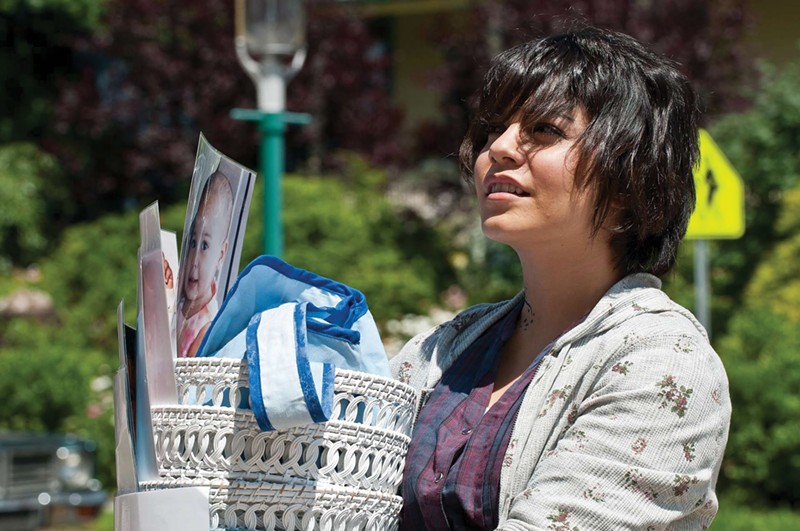Imagine, if you will, living in a hellhole, deep, dank and dark. You’re a teen forced to turn tricks by your mother to pay your own way, while also knowing that your earnings are feeding her drug habit. One day, you’ve had enough. You’re tired of looking at all of the other girls, all of those reflections with dead eyes and dirty toothless smiles. You leave with nothing but a faded letter, folds worn deep; it’s all you have — hope, promise, your way out.
This is how Gimme Shelter begins, and writer-director Ron Krauss allows it to unspool almost wordlessly. Agnes “Apple” Bailey (Vanessa Hudgens) hides behind a curtain of black greasy hair that is simply no match for the walking dead look in her eyes. She runs, but there’s no belief in her, no sense that she can truly escape. The letter might be a MacGuffin.
And in a key way, it is. It’s a plea from Apple’s father Tom Fitzpatrick (Brendan Fraser), an apology for missing out on being a presence in her life. By the time Apple reaches him, she finds a man living another life, in another world. Rich and married with a young son, Tom wants to do the right thing, but Apple’s situation is further complicated by their discovery that she’s pregnant and completely unwilling to “handle” things the way Tom’s wife (Stephanie Szostak) argues. Apple has no means to care for herself; she’s set to end up just like her mother (Rosario Dawson).
So she runs again, fueled now with passion and determination. She will not terminate her pregnancy and she won’t follow in her mother’s footsteps. In her shoes, what would you do?
A kindly priest (James Earl Jones) steers Apple to a shelter for pregnant teens and teen mothers run by Kathy (Ann Dowd). Girls from a variety of backgrounds bond in the safety and security of their shared experiences with support from Kathy. She feeds them, drives them to medical appointments and mothers them (with a sprinkle of tough love in the mix), thus offering an example of what it means to care for someone else.
Gimme Shelter is based on a true story, but not the one we would expect. The simple version of the tale would be Several Sources Shelters founder Kathy DiFiore’s. We would see her struggles, her triumph, and that would provide the inspiration for her desire to give back.
Yet, what Krauss has done is more subtle and far more empowering. His film journey began with word of mouth about a group of shelters in New Jersey providing aid to homeless women. By happenstance, one of the shelters was near his brother’s home, so during a family gathering around the holidays, Krauss dropped by and met DiFiore. As Krauss discussed in a recent phone interview, he was fascinated by this “selfless network, of kindness, helping people in difficult times. Back in 2010, we were going through some of the worst economic times in U.S. history and here was a woman reaching out to help people.”
That interest led to documentation without consideration for a movie. The time spent with the women, Krauss said, “touched me so deeply, I felt there had to be an opportunity to raise awareness, to inspire others.” When Krauss finally struck upon the idea of making a movie, at first DiFiore said no, but quickly realized that there was potential to spread the word about her (and her organization’s) efforts. “She said, ‘you can do a movie, not about her, but the work and the girls in the shelter. That will make sense to people,’” Krauss said.
Krauss spent a year living in one of the shelters while writing the script. “I ended up coming back to the shelter to shoot the movie with actors and some of the real people from the shelter,” he said. Krauss likened the story of Gimme Shelter to a war: “A different kind of war. It’s people fighting back, coming out of this terrible economic situation and putting their lives back together. And I was writing this while I was in this war, in the shelter. I didn’t try to glamorize it; I wanted it to be as realistic as possible. The way the story is told, the way it looks. And there wasn’t a happy ending on the film, per se. It’s a hopeful ending, but not a happy ending.”
That sense of uplift extends beyond the big screen. Audiences have the opportunity to plug into the social media network of Kathy DiFiore’s Several Sources Shelters (severalsourcesfdn.org) and the film’s official website, Facebook and Twitter to learn more about not just Several Sources Shelters, but social service outlets in communities throughout the country. Join the network, help provide shelter and respite. (Opens Friday)
CONTACT TT STERN-ENZI:
[email protected]






